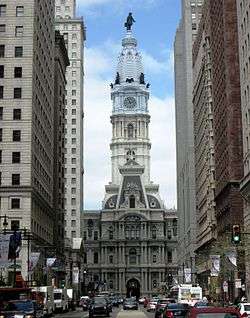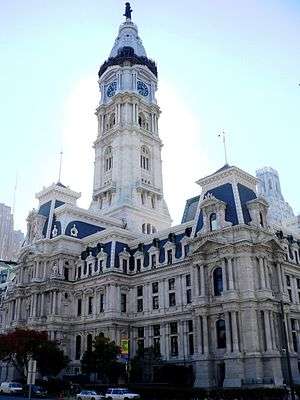Philadelphia City Hall
| Philadelphia City Hall | |
|---|---|
|
Philadelphia City Hall | |
| Record height | |
| Tallest in the world from 1894 to 1908[I] | |
| Preceded by | Ulm Minster |
| Surpassed by | Singer Building |
| General information | |
| Status | Complete |
| Location |
1 Penn Square Philadelphia, PA 19107 USA |
| Completed | 1901 |
| Height | |
| Antenna spire | 548 ft (167 m) |
| Technical details | |
| Floor count | 9 |
|
Philadelphia City Hall | |
|
Philadelphia City Hall c1899 | |
| Location | Philadelphia, Pennsylvania |
| Coordinates | 39°57′8.09″N 75°9′50.02″W / 39.9522472°N 75.1638944°WCoordinates: 39°57′8.09″N 75°9′50.02″W / 39.9522472°N 75.1638944°W |
| Area | 630,000 ft² (58,222 m²)[1] |
| Built | 1871–1901 |
| Architect |
John McArthur, Jr. Thomas U. Walter |
| Architectural style | Second Empire, other |
| NRHP Reference # | 76001666[2] |
| Added to NRHP | December 8, 1976 |
Philadelphia City Hall, located at 1 Penn Square, is the seat of government for the city of Philadelphia, in the commonwealth of Pennsylvania.
At 548 ft (167 m), including the statue of city founder William Penn atop it, it was the tallest habitable building in the world from 1894 to 1908. It remained the tallest in Pennsylvania until it was surpassed in 1932 by the Gulf Tower in Pittsburgh; it was the tallest in Philadelphia until the construction of One Liberty Place (1984–87) ended the informal gentlemen's agreement that limited the height of buildings in the city. Today, it is the state's 16th-tallest building.
City Hall has been the world's tallest masonry building since at least the 1953 collapse of the pinnacle of the Mole Antonelliana in Turin.[3][4] Its weight is borne by granite and brick walls up to 22 feet (6.7 m) thick. The principal exterior materials are limestone, granite, and marble.
In 2007, the building was voted #21 on the American Institute of Architects' list of Americans' 150 favorite U.S. structures.[5]
History and description
_p11_STATUE_OF_WILLIAM_PENN.jpg)

The building was designed by Scottish-born architect John McArthur, Jr., in the Second Empire style, and was constructed from 1871 until 1901 at a cost of $24 million. City Hall was topped off in 1894, although the interior wasn't finished until 1901. Designed to be the world's tallest building, it was surpassed during construction by the Washington Monument and the Eiffel Tower, though it was at completion the world's tallest habitable building. It was the first modern building (excluding the Eiffel Tower) to be the world's tallest and also was the first secular habitable building to have this record: all previous world's tallest buildings were religious structures, including European cathedrals and, for the previous 3,800 years, the Great Pyramid of Giza.
With almost 700 rooms, City Hall is the largest municipal building in the United States.[6] The building houses three branches of government, playing host to the city's executive branch (the Mayor's Office), its legislature (the Philadelphia City Council), and a substantial portion of the judicial activity in the city (with the Civil Division and Orphan's Court of the Pennsylvania Court of Common Pleas for the First Judicial District being housed there, as well as chambers for some criminal judges and some judges of the Philadelphia Municipal Court).
William Penn Statue
The building is topped by an 11.3 m (37 ft), 27-ton bronze statue of city founder William Penn, one of 250 sculptures created by Alexander Milne Calder that adorn the building inside and out. The statue is the tallest atop any building in the world.
Calder wished the statue to face south so that its face would be lit by the sun most of the day, the better to reveal the details of his work. The statue actually faces northeast, towards Penn Treaty Park in the Fishtown section of the city, which commemorates the site where William Penn signed a treaty with the local Native Americans tribe.[7] Beyond Penn Treaty Park is Pennsbury Manor, Penn's country home in Bucks County. Yet another version for why the statue pointed generally north instead of south is that it was the current architect's method of showing displeasure with the style of the work. By 1894, the statue's design was not in the current, popular Beaux-Arts style and was considered out-of-date even before it was placed on top of the building. Penn's statue is hollow, and a narrow access tunnel through it leads to a small (22-inch-diameter (56 cm)) hatch atop the hat.
By the terms of a gentlemen's agreement that forbade any structure from rising above the brim of the hat on the William Penn statue, Philadelphia City Hall remained the tallest building in the city until it was surpassed by One Liberty Place in 1987. The abrogation of this agreement supposedly brought a curse onto local sports teams.
During the 1990s, whenever one of Philadelphia's four major sports teams was in contention for a championship, the statue was decorated with the jersey or hat of that team.
Other Features and history
The tower features clocks 8 m (26 ft) in diameter on all four sides of the metal portion of the tower (larger than the Clock Tower, Palace of Westminster).[8] This clock was designed by Warren Johnson.
City Hall's observation deck is located directly below the base of the statue, about 152 m (499 ft) above street level. Once enclosed with chain link fence, the observation deck is now enclosed by glass. It is reached in a 6-person elevator whose glass panels allow visitors to see the wooden superstructure that supports the tower. Stairs within the tower are only used for emergency exit. The ornamentation of the tower has been simplified; the huge garlands that festooned the top panels of the tower were removed.
In the 1950s, the city fathers investigated tearing down City Hall for a new building elsewhere. They found that the demolition would have bankrupted the city due to the building's masonry construction.
Beginning in 1992, Philadelphia City Hall underwent a comprehensive exterior restoration, planned and supervised by the Historical Preservation Studio of Vitetta Architects & Engineers, headed by renowned historical preservation architect, Hyman Myers.[9] The majority of the restoration was completed by 2007, although some work has continued, including the installation of four new ornamental courtyard gates, based on an original architectural sketch, in December, 2015.[10][11][12]
City Hall became a National Historic Landmark in 1976. In 2006, it was also named a National Historic Civil Engineering Landmark by the American Society of Civil Engineers.[13]
Site


City Hall is built on the area designated by William Penn as Centre Square. It was a public square from the city's founding in 1682 until the construction of City Hall began upon the site in 1871. It was one of the five original squares of Philadelphia laid out on the city grid by Penn.[14] It lay at the geographic heart of the city from 1682 until the Act of Consolidation, 1854 (although it was never the social heart of the city during that long period).
Penn planned for Centre Square to be:
a central square or plaza of ten acres to be bordered by the principal public buildings, such as the Quaker meetinghouse, the state house, the market house, and the schoolhouse. Despite the two riverfronts [Delaware and Schuylkill], Penn's city had an inward-facing design, focusing on this central plaza.[15]
However, the Delaware riverfront would remain the de facto economic and social heart of the city for more than a century.
[…] hardly anyone lived west of Fourth Street before 1703. Consequently Penn's design of a center square as the hub of his community had to be abandoned. The large Friends meeting house which was built in 1685 at the midpoint between the rivers was dismantled in 1702. Efforts to develop the Schuylkill waterfront likewise collapsed. Of the merchants, tradesmen, and craftsmen who can be identified as living in Philadelphia around 1690, 123 lived on the Delaware side of town and only 6 on the Schuylkill side. One of the latter, a tailor named William Boulding, complained that he had invested most of his capital in his Schuylkill lot, 'so that he cannot, as others have done, Remove from the same.' Not until the mid-nineteenth century, long after the city had spilled northward and southward in an arc along the Delaware miles beyond its original limits, was the Schuylkill waterfront fully developed. Nor was Centre Square restored as the heart of Philadelphia until the construction of City Hall began in 1871.[15]
The west side of the original square had returned to green space in 2014 as Dilworth Park.
See also
 Philadelphia portal
Philadelphia portal- List of tallest buildings in Philadelphia
- Philadelphia City Council
- Philadelphia
- Parliament Building, Quebec City: Built at approximately the same time in the same style, leading to a striking similarity.
- National Register of Historic Places listings in Center City, Philadelphia
References
Notes
- ↑ "Philadelphia City Hall". Retrieved 12 November 2016. Technical specs of City Hall
- ↑ National Park Service (2006-03-15). "National Register Information System". National Register of Historic Places. National Park Service.
- ↑ Sources differ on the original height of the Mole Antonelliana's pinnacle, and while the current structure is higher, it was rebuilt and reinforced with steel, ending its claim as a masonry structure. "Mole Antonelliana, Turin". SkyscraperPage. 2011. Retrieved 3 March 2011.
- ↑ "Philadelphia City Hall, Philadelphia". SkyscraperPage. 2011. Retrieved 3 March 2011.
- ↑ Other Philadelphia buildings on the list included the Philadelphia Museum of Art, the Fisher Fine Arts Library at the University of Pennsylvania, 30th Street Station, and Wanamaker's department store."America's Favorite Architecture". (February 9, 2005). American Institute of Architects. Retrieved April 23, 2014
- ↑ "Philadelphia City Hall, Philadelphia". Emporis. 2011. Retrieved 3 March 2011.
- ↑ Hornblum, Allen M. (2003). Philadelphia's City Hall. Arcadia Publishing. p. 63.
- ↑ "City Hall Virtual Tour".
- ↑ "City Hall Sets Up Eight-year Plan To Clean Up Its Act $130 Million Project To Restore Building's Luster". philly-archives. Retrieved 2016-02-17.
- ↑ Adams, Jennifer (2012). "Reviving A National Landmark". Retrieved February 17, 2016.
- ↑ Marsh, Bill (July 25, 2006). "People Stop Fighting Philadelphia City Hall". www.nytimes.com. Retrieved February 17, 2016.
- ↑ Harris, Linda K. (September 9, 2015). "First of Four Monumental Portal Gates Installed at City Hall". www.centercityphila.org. Retrieved February 17, 2016.
- ↑ "asce_news_Philadelphia City Hall Named as Historic Landmark". Archived from the original on 2007-09-27. Retrieved 2007-04-03.
- ↑ "Philadelphia Parks – William Penn vision of". fishtownonline.
- 1 2 Weigley, RF; et al. (1982). Philadelphia: A 300-Year History. New York and London: W. W. Norton & Company. ISBN 0-393-01610-2.
Further reading
- Gurney, George, Sculpture of a City—Philadelphia's Treasures in Bronze and Stone, Fairmount Park Association, Walker Publishing Co., Inc., New York, NY, 1974.
- Hayes, Margaret Calder, Three Alexander Calders: A Family Memoir by Margaret Calder Hayes, Paul S. Eriksson, publisher, Middlebury, Vermont, 1977.
- Lewis, Michael J. "‘Silent, Weird, Beautiful’: Philadelphia City Hall," Nineteenth Century, vol. 11, nos. 3 and 4 (1992), pp. 13–21
External links
| Wikimedia Commons has media related to Philadelphia City Hall. |
- Official site
- Philadelphia City Hall at skyscraperpage.com
- Philadelphia City Hall at aviewoncities.com
- Philadelphia City Hall at CityMayors.com
- Philadelphia City Hall – historical information from Philadelphia Architects and Buildings
- Google Street View
- "Layer Cake (City Hall)" by James G. Mundie

